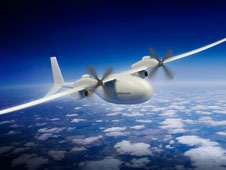’s unmanned hydrogen-powered Phantom Eye HALE demonstrator aircraft has arrived at NASA’s Dryden Flight Research Centre for assembly and preparations for flight tests.
NASA Dryden is hosting the Boeing flight test operation, providing hangar facilities, engineering, ground test and test range support for the project. The aircraft is expected to fly sometime this year.
Flight testing of the Phantom Eye, like those of Boeing’s smaller Phantom Ray unmanned air vehicle that arrived at Dryden late last year, will be conducted under a Boeing-funded commercial Space Act agreement with NASA. The aircraft, in several crates, arrived at Dryden March 25 after being trucked from the company’s Phantom Works facilities in St. Louis, Mo.
Developed by Boeing with internally generated funds, the Phantom Eye is a propeller-driven lightweight aircraft with a high aspect ratio, 150-foot-long wing. Its hydrogen-fuelled propulsion system’s fuel economy, coupled with its use of winds to stay on station, is expected to enable the aircraft to stay aloft for up to four days while carrying a 450-pound payload. It is powered by two modified Ford automotive engines.
The Phantom Eye technology demonstrator is the forerunner of a planned larger version of the craft that is being designed to remain aloft for up to 10 days. The larger version could carry payloads weighing more than 2,000 pounds for persistent intelligence, surveillance, reconnaissance and communications missions.
Phantom Eye is an evolution of Boeing’s Condor aircraft that set several records for altitude and endurance in the late 1980s.

